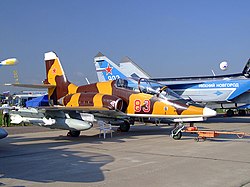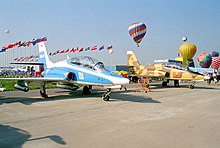Mikoyan-Gurevich MiG-AT
| Mikoyan-Gurevich MiG-AT | |
|---|---|
 Mikojan-Gurewitsch MiG-AT at the MAKS 2007 |
|
| Type: | Jet trainer |
| Design country: | |
| Manufacturer: | |
| First flight: |
March 21, 1996 |
| Production time: |
so far no series production |
| Number of pieces: |
2 |
The Mikoyan-Gurewitsch MiG-AT ( Russian Микоян-Гуревич МиГ-АТ ) was the prototype of a Russian training aircraft .
history
At the end of the 1980s, tenders began for a modern advanced trainer for the Soviet air force , which was supposed to replace the existing L-29 and L-39 trainers. In the first selection round, the Jak-130 and the Mikojan-Gurevich MiG-AT were confirmed, and prototypes were approved for both types. As early as 1992, this aircraft was developed in close cooperation with French companies in order to avoid possible engine problems and at the same time to open up possible export markets. A Turboméca SNECMA engine - built under license - and a sextant avionics system are used in the MiG-AT. The composite wings are made in South Korea . The aim was to get a trainer who could do the same maneuvers as the MiG-29 and Su-27 . For this reason, the load limits were designed for +8 g and −3 g , respectively . Two prototypes have been built: one with French avionics (ATF) and one with Russian electronics (ATR). The basic version for export should also receive French engines. The official first flight was on March 21, 1996. In 2002 the Jak-130 won against the MiG-AT due to a more modern design.
Construction work for a single-seat ground combat version of the MiG-ATB was also started in 1996. Although there were no orders, the manufacturer wanted to offer the fully developed MiG-AT to foreign customers.
In 2008 the Saturn AL-55 was tested as a possible engine in the MiG-AT.
Technical specifications
| Parameter | Data |
|---|---|
| crew | 2 (student pilot and instructor) |
| length | 12.01 m |
| span | 10.16 m |
| height | 4.62 m |
| Wing area | 17.67 m² |
| Empty mass | at least 3300 kg |
| normal takeoff mass | 4610 kg |
| Max. Takeoff mass | approx. 7000 kg |
| Top speed | 850 km / h (sea level) or 1000 km / h at an altitude of 2500 m |
| Initial rate of climb | 67 m / s |
| Service ceiling | 15,500 m |
| Transfer range | 2600 km |
| Engines | 2 × Snecma-Turbomeca Larzac-04-R20 , each 14.1 kN (MiG-ATF) or 2 × Soyuz-RD-1700, each 17 kN (MiG-ATR) |
Armament
- Payload of up to 2000 kg on seven external load carriers
- Air-to-air guided missile
- 2 × Wympel R-73E (AA-11 Archer) - infrared controlled short-range air-to-air guided missile
- Unguided air-to-surface missiles
- 4 × GosMKB Wympel B8M1 rocket launch containers for 20 × unguided S-8 air-to-ground missiles each ; Caliber 80 mm
- Free falling bombs
- 2 × Basalt FAB-500M-62 (500 kg free-fall bomb )
- 4 × Basalt FAB-250M-54 (234 kg free-fall bomb)
- 4 × Basalt FAB-100 (100 kg free fall bomb)
- 4 × Basalt FAB-50 (50 kg free fall bomb)
- External container
- 2 × UPK-23-250 automatic cannon containers each for a double-barreled 23 mm automatic cannon Grjasew-Schipunow GSch-23L with 250 rounds of ammunition
See also
Web links
Individual evidence
- ↑ suchoj.com and flightglobal.com
- ↑ АЛ-55И проходит испытания на МиГ-АТ. In: razlib.ru. September 2008. Retrieved on September 30, 2017 (Russian).
- ↑ АЛ-55И успешно проходит испытания. In: aviaport.ru. November 14, 2008. Retrieved September 30, 2017 (Russian).

